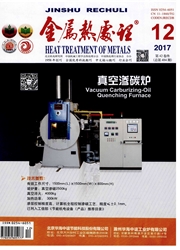

 中文摘要:
中文摘要:
通过光学显微镜、透射电子显微镜和硬度测试,研究了析出相尺寸不同的冷变形Cu-0.36Cr(wt%,下同)合金的抗软化性能和高温再结晶行为。结果表明,Cr可以有效地阻碍再结晶过程,提高材料抗高温软化性能;在退火过程中可发生原位再结晶和不连续再结晶两种再结晶形式,再结晶的形式主要取决于析出相颗粒的大小,可以钉扎住晶界移动的Cr析出相的临界尺寸约为43.8 nm,小于临界尺寸的析出相促使原位再结晶发生,原位再结晶后析出相仍比较细小,合金保持较高硬度;而且析出相尺寸还可以影响再结晶的开始温度和速度。
 英文摘要:
英文摘要:
Softening resistant performance and recrystallization behavior of cold-deformed Cu-0. 36Cr alloy with different size of precipitates at high temperature was investigated with optical microscopy, TEM and hardness tests. The results show that addition of Cr can hinder recrystallization and improve the softening resistant performance at high temperature. There are in situ recrystallization and discontinuous recrystallization at annealing temperature. The process of recrystallization is dominated by the size of precipitates before cold-deformation. The critical size of Cr precipitates which can pin grain boundary is 43.8 nm approximately. The in situ recrystallization can be promoted by finer precipitates which size is smaller than the critical size, and these precipitates are still fine after in situ recrystallization and the hardness of the alloy still maintains a higher value. Also the size of Cr precipitates can influence the initiative temperature and the velocity of recrystallization.
 同期刊论文项目
同期刊论文项目
 同项目期刊论文
同项目期刊论文
 期刊信息
期刊信息
